Transcription of Syringe Driver Drug Compatibilities Guide to …
1 Eastern Metropolitan Region Palliative Care Consortium (Victoria) Clinical Group Syringe Driver drug Compatibilities Guide to Practice 2013 July 2013 These guidelines have been copyrighted. The Eastern Metropolitan Region Palliative Care Consortium (EMRPCC) grants permission to reproduce parts of this publication for clinical and educational use only, provided that the EMRPCC is acknowledged. Requests to reproduce this document, for purposes other than those stated above, should be addressed to: Consortium Manager Eastern Metropolitan Region Palliative Care Consortium c/- PO Box 2110 Rangeview 3132 Victoria Australia or Page 2 of 20 The EMRPCC welcomes feedback regarding recommendations for the planned review process in 2016.
2 Please send your comments to the Consortium Manager at: INSTRUCTIONS FOR USE These guidelines work best if used electronically. The Contents have hyperlinks to each section. Printing: It is highly recommended these guidelines are printed in colour, to aid ease of use. Contents DISCLAIMER .. 3 KEY .. 3 4 Infusion site problems .. 4 Diluent information .. 4 Atropine .. 5 Clonazepam .. 5 6 Fentanyl .. 8 Glycopyrrolate .. 9 Haloperidol .. 10 Hydromorphone .. 12 Hyoscine Butylbromide (Hyoscine BBr) .. 13 Hyoscine Hydrobromide (Hyoscine HBr) .. 14 Ketamine .. 15 15 Levomepromazine .. 16 Lignocaine .. 17 Methadone .. 17 Metoclopramide .. 17 Midazolam .. 18 Morphine Sulfate .. 19 Octreotide .. 19 Ondansetron .. 19 Oxycodone .. 19 Sufentanil.
3 19 REFERENCES .. 20 Acknowledgements .. 20 Eastern Metropolitan Region Palliative Care Consortium Clinical Working Party 2013 Page 3 of 20 DISCLAIMER The information in this document is intended as a guideline only. It is the responsibility of the user to ensure information in this document is used correctly. These guidelines reflect current Australian/Victorian palliative care practice and published evidence. Caution should be used when combining drugs in Syringe drivers ; mixtures should be closely monitored for discolouration, precipitation and crystallisation. All drug compatibility combinations derived from these guidelines should be checked and prescribed by a medical doctor with appropriate experience before administering.
4 If you require further information regarding drug combinations and compatibility data, contact a specialist hospital-based pharmacy drug information service. drug doses should be modified in response to the patient/client s clinical situation and status, including previous exposure to opioids and concurrent medications. When administering opioids, and setting up Syringe drivers , follow your organisation s policy and procedures. All patients should be monitored closely when commencing and/or switching opioid medications. KEY Instructions for reading the list of drugs All drugs are listed in alphabetical order. When searching for drug combinations, search by the drug which occurs first alphabetically. drug combinations are not repeated in reverse order Example.
5 Haloperidol Haloperidol, Hydromorphone Haloperidol, Hydromorphone, Metoclopramide Symbol Explanation Compatible, observational data from clinical setting A,B,C Compatible, read note for explanation Conflicting information regarding compatibility proceed with caution Incompatible NaCl Diluent = Sodium Chloride (NaCl ) WFI Diluent = Water For Injection (WFI) NaCl WFI Diluent = Sodium Chloride (NaCl ) or Water for Injection (WFI) NOTE A Chemically compatible in tests NOTE B Physically compatible in tests NOTE C Potential for site reaction see Infusion Site Problems Eastern Metropolitan Region Palliative Care Consortium Clinical Working Party 2013 Page 4 of 20 Compatibility Chemical compatibility (note A) Chemical compatibility data is obtained by laboratory analysis the drug combination in the range of combinations usually used, in the usual diluent and over a range of temperatures.
6 Physical compatibility (note B) Physical compatibility data can also be obtained by laboratory analysis. The lack of physical change such as discoloration, clouding or crystallization is tested microscopically. Compatibility data gathered from the clinical setting is the observation for any physical changes, as well as clinical assessment. This data is documented as compatible, observational data from clinical setting. When combining medications for Syringe Driver use, be aware there is data available from compatibility studies for only a few drug combinations. It is recommended that the number of medications in one Syringe Driver be limited to three. If several medications are required, consider using more than one Syringe Driver where this is practical.
7 The more medications that are mixed in one Syringe , the higher the potential for interaction, particularly where pH differs. If the combination is not listed in this practice guideline, consult 1. Dickman A, Schneider J. The Syringe Driver Continuous subcutaneous infusions in palliative care. 3rd ed. Oxford: Oxford University Press; 2011 (1) 2. The Syringe Driver database on the palliative care website (2) Infusion site problems (note C) A plastic (Teflon or Vialon ) cannula should be used rather than a metal butterfly needle to reduce site inflammation. A skin reaction at the infusion site is most commonly found with cyclizine, ketamine, levomepromazine and methadone. Excluding mixtures containing cyclizine, sodium chloride can be used as the diluent in an attempt to reduce site reactions with irritant infusions.
8 Sites may last up to a week, depending on the drugs used. The site should be changed if painful or inflamed. Routine rotation to a different subcutaneous site every 72 hours reduces the frequency of site problems. If frequent resiting is necessary, every 24 to 48 hours, consider the following strategies: Use a larger Syringe to enable a more dilute mixture to be used, thereby decreasing the final drug concentrations Change to a 12 hourly regimen, thereby permitting further dilution of the drugs Change an irritant drug to a less irritant alternative Inject dexamethasone 1mg directly into the infusion site, via the cannula to be used. Flush with NaCl then connect the Syringe Driver and commence.(1) Chlorpromazine, diazepam and prochlorperazine These drugs are not recommended to be given by subcutaneous infusion due to severe local reactions.
9 (3) Phenobarbitone Phenobarbitone has an alkaline pH and can cause tissue necrosis when administered as subcutaneous bolus injection. In practice, phenobarbitone can be initiated with a bolus intramuscular or intravenous injection, then via subcutaneous infusion with NaCl or WFI as diluent. It should be given via a separate Syringe Driver . Seek specialist advice. (1) Further information Guidelines for Subcutaneous Infusion Device Management in Palliative Care second edition 2010 available at (4) Diluent information Sodium Chloride (NaCl ) and Water for Injection (WFI) are suitable for subcutaneous infusions. Diluting Syringe contents as much as possible is recommended to reduce site irritation.
10 NaCl is recommended as the diluent of choice when drugs are compatible with more than one solution. It is closest to physiological tonicity, therefore less likely to cause irritation. The main exception to this is cyclizine which should always be diluted in WFI. Syringe Driver drug Compatibilities Guide to Practice 2013 A: Chemically compatible in tests B: Physically compatible in tests C: Potential for infusion site problem Eastern Metropolitan Region Palliative Care Consortium Clinical Working Party 2013 Page 5 of 20 drug COMPATIBILITY DILUENT COMMENT REFERENCE Atropine NaCl Atropine may be administered via continuous subcutaneous infusion, but is not commonly used in Australia. Information on compatibility with other drugs is limited therefore not recommended 5 Clonazepam NaCl WFI There is a significant loss when infused through PVC tubing which can be addressed by using non PVC tubing or titrating the dose to desired effect 1 Clonazepam, Glycopyrrolate, Oxycodone NaCl 2 Clonazepam, Haloperidol, Methadone C NaCl 1 Clonazepam, Haloperidol, Morphine Sulfate NaCl WFI 2 Clonazepam, Haloperidol, Morphine Tartrate NaCl 1 Clonazepam, Haloperidol, Oxycodone B NaCl WFI 1 Clonazepam, Hydromorphone NaCl 2 Clonazepam, Hyoscine Butylbromide NaCl WFI 2 Clonazepam, Hyoscine Butylbromide, Morphine Sulfate NaCl 1 Clonazepam, Hyoscine Butylbromide.



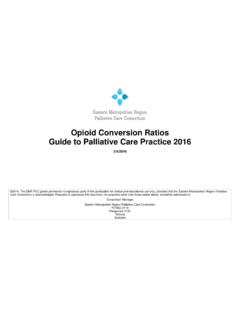

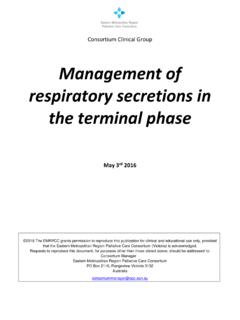

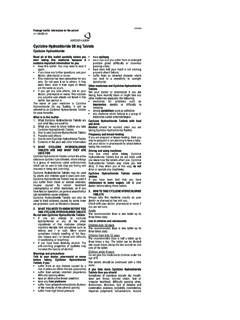
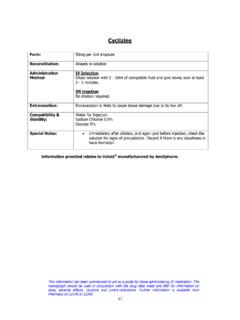

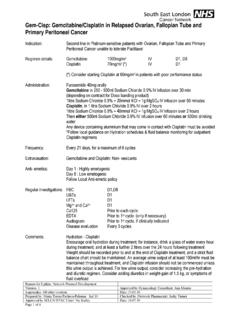
![[P] Clonazepam - Palliative Care](/cache/preview/7/3/1/8/c/1/0/f/thumb-7318c10f561f7c7ba618d52f79801a4d.jpg)
